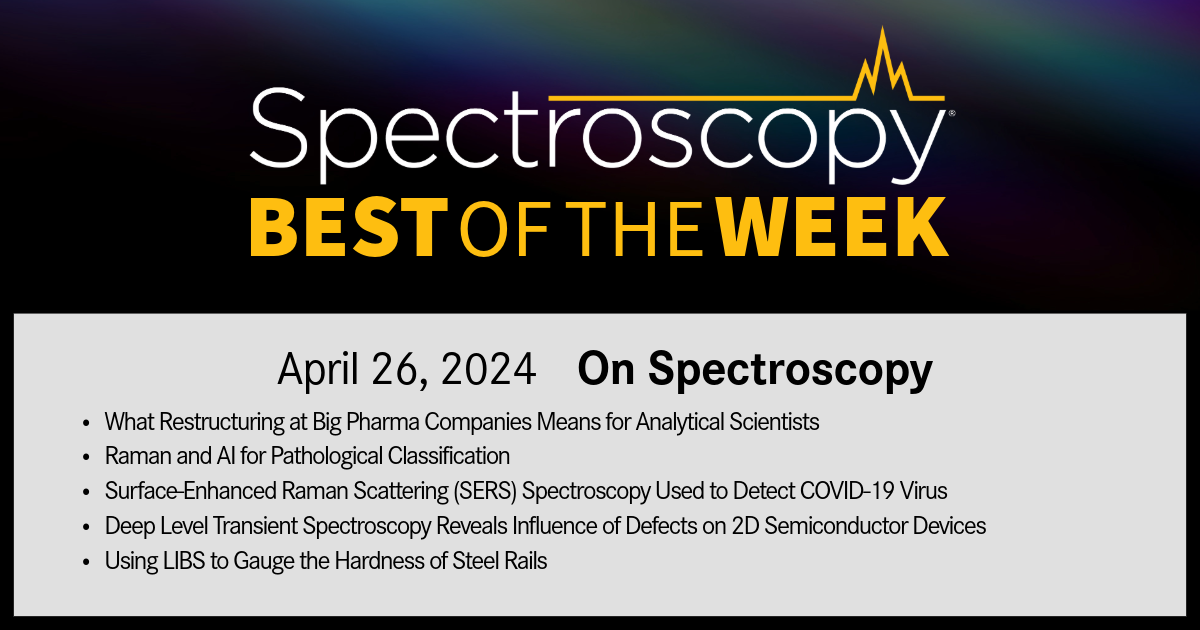Best of the Week: Big Pharma Restructuring, Raman Spectroscopy, Artificial Intelligence
This week, Spectroscopy published a variety of articles on the hottest topics in analytical science. Below, we’ve highlighted some of the most popular articles, according to our readers. Happy reading!

What Restructuring at Big Pharma Companies Means for Analytical Scientists
Caroline Hroncich
On April 25, 2024, Bristol Meyers Squibb (BMS) announced that it will cut $1.5 billion in costs by the end of 2025, including laying off more than 2000 employees. This continues the trend of layoffs from Big Pharma compies like Pfizer, Genentech, Sanofi, and GlaxoSmithKline. This could prove worrisome for analytical scientists, who typically look for roles at these companies in lieu of academic laboratories. While analytical scientists are feeling positive about the job market, this sentiment does not come without challenges. Here, we discuss what Big Pharma restructuring could mean for the future of analytical chemistry.
Raman and AI for Pathological Classification
Aaron Acevedo
Using artificial intelligence alongside analytical chemistry has become a hot topic among scientists. Machine learning has been particularly interesting, since it can self-iterate and optimize problem solving for modeling data in an automated way using computational algorithms. These methods can be used in image and speech recognition, natural language processing, and predictive modeling, among other areas. In this study out of Biahang University and Capital Medical University in Beijing, China, scientists used machine learning technology in combination with Raman spectroscopy to streamline the pathological classification process.
Surface-Enhanced Raman Scattering (SERS) Spectroscopy Used to Detect COVID-19 Virus
Aaron Acevedo
The COVID-19 pandemic caused an unprecedented need for rapid, sensitive, and cost-effective point-of-care diagnostic tests to prevent and mitigate the spread of the SARS-CoV-2 virus. Spectroscopy techniques have been used to detect the virus, protecting against the disease, and helping to screening for long COVID. In this study, the scientists demonstrated an advanced lateral flow immunoassay (LFIA) platform with dual-functional (colorimetric and surface-enhanced Raman scattering [SERS]) detection of the spike 1 (S1) protein of SARS-CoV-2. This system was made in hopes to make a new point-of-care platform for the early detection of SARS-CoV-2 and other respiratory virus infections.
Deep Level Transient Spectroscopy Reveals Influence of Defects on 2D Semiconductor Devices
Will Wetzel
Semiconductors, which are mostly used for clean energy products like self-driving vehicle circuits and solar cells, have become a hot topic in spectroscopy circles. Their production is important to society, but it is also important to ensure that the materials used to construct semiconductors are of optimal condition to prevent any defects with their electrical properties. Vibrational spectroscopic techniques have previously been used to characterize, optimize, and analyze semiconductor materials. In this study, researchers from the Institute of Electrical and Microengineering in Lausanne, Switzerland, led by Andras Kis, delved into analyzing 2D semiconductors and their electrical defects. This was done by using deep level transient spectroscopy (DLTS).
Using LIBS to Gauge the Hardness of Steel Rails
Will Wetzel
The steel industry has been essential to commerce and transportation since the Industrial Revolution, with steel being used in various important projects. This includes rail lines that allow locomotives and trains to transport good and people more efficiently. With how used trains are today, it is vital that the tracks they travel on remain in optimal condition. As such, the hardness of the steel rails used on these tracks must be measured. In this study from Zefeng Yang of Southwest Jiaotong University in Chengdu, China, laser-induced breakdown spectroscopy (LIBS) was used along machine learning technique to evaluate the hardness of steel rails for essential infrastructure projects.
AI-Powered SERS Spectroscopy Breakthrough Boosts Safety of Medicinal Food Products
April 16th 2025A new deep learning-enhanced spectroscopic platform—SERSome—developed by researchers in China and Finland, identifies medicinal and edible homologs (MEHs) with 98% accuracy. This innovation could revolutionize safety and quality control in the growing MEH market.
New Raman Spectroscopy Method Enhances Real-Time Monitoring Across Fermentation Processes
April 15th 2025Researchers at Delft University of Technology have developed a novel method using single compound spectra to enhance the transferability and accuracy of Raman spectroscopy models for real-time fermentation monitoring.
Nanometer-Scale Studies Using Tip Enhanced Raman Spectroscopy
February 8th 2013Volker Deckert, the winner of the 2013 Charles Mann Award, is advancing the use of tip enhanced Raman spectroscopy (TERS) to push the lateral resolution of vibrational spectroscopy well below the Abbe limit, to achieve single-molecule sensitivity. Because the tip can be moved with sub-nanometer precision, structural information with unmatched spatial resolution can be achieved without the need of specific labels.